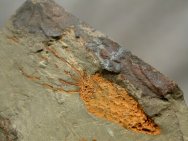Sinoeocrinus
sp.
Phylum
Echinodermata, Family Eocrinidae
Geological
Time: Early Middle Cambrian
Size: 65
mm by 43 mm matrix
Fossil
Site: Kaili Formation, Maiobanpo Section, Taijiang County, Kaili,
Guizhou Province, China
 The
Kaili Biota of Guiznou Province China, like the fantastic Chengjiang
and Burgess Shale Fauna, preserve
some of the earliest radiations of complex life known on the planet.
The formation is some 220 m in thickness and spans the Late Early
to Early Middle Cambrian. As such it is intermediate in age between
the Changjiang and Burgess Shale Faunas. Representatives of some
110 genera are known, representing 11 phyla. The Kaili Biota includes
both soft-bodied and skeletonized animals, and is dominated by trilobites.
It shares roughly 30 genera in common with Chengjiang and nearly
40 with the Burgess Shale. There are also a number of eocrinoid
Echinoderms, with three members of the gogiid genus Sinoeocrinus
predominating. The Echinoderms remained a modest component of the
Cambrian biota until favorable environmental shifts allowed for
a rapid radiation. Many appear to have had no holdfast for anchoring
to the seafloor. When hard substrates became more common, the eocrinoids
were able to exploit their advantage. The rapid rise of the echinoderms
that occurred during the Ordovician included the appearance of the
first true crinoids. The
Kaili Biota of Guiznou Province China, like the fantastic Chengjiang
and Burgess Shale Fauna, preserve
some of the earliest radiations of complex life known on the planet.
The formation is some 220 m in thickness and spans the Late Early
to Early Middle Cambrian. As such it is intermediate in age between
the Changjiang and Burgess Shale Faunas. Representatives of some
110 genera are known, representing 11 phyla. The Kaili Biota includes
both soft-bodied and skeletonized animals, and is dominated by trilobites.
It shares roughly 30 genera in common with Chengjiang and nearly
40 with the Burgess Shale. There are also a number of eocrinoid
Echinoderms, with three members of the gogiid genus Sinoeocrinus
predominating. The Echinoderms remained a modest component of the
Cambrian biota until favorable environmental shifts allowed for
a rapid radiation. Many appear to have had no holdfast for anchoring
to the seafloor. When hard substrates became more common, the eocrinoids
were able to exploit their advantage. The rapid rise of the echinoderms
that occurred during the Ordovician included the appearance of the
first true crinoids.
This
eocrinoid is one of the basal progenitors of the Echinoderm radiation
in the Cambrian. The presence of Burgess Shale–like fauna
over a large part of southwestern China shows that the faunal community
was quite cosmopolitan in nature, indicating that preservation was
more of a factor in finding these concentrations of animals than
was the existence of isolated communities suitable for harboring
these myriad life forms.
|
|




